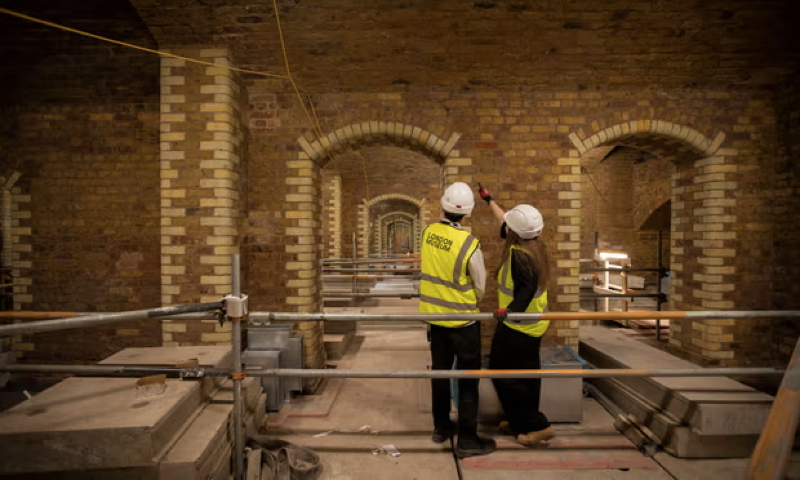Man who is missing 90% of his brain leads a normal life

Hi everyone! Mathew Ingram here. As many of you probably know, I am able to continue writing this newsletter in part because of your financial help and support, which you can do either through my Patreon or by upgrading your Ghost subscription to a monthly contribution. I enjoy gathering all of these links and sharing them with you, but it does take time, and your support makes it possible for me to do that. And I appreciate it, believe me! If you like this newsletter, please share it with someone else. Thanks for being a reader!

From CBC: "When a 44-year-old man from France started experiencing weakness in his leg, he went to the hospital. That's when doctors told him he was missing most of his brain. The man's skull was full of liquid, with just a thin layer of brain tissue left, a condition is known as hydrocephalus. "He was living a normal life. He has a family. He works. His IQ was tested at the time of his complaint. This came out to be 84, which is slightly below the normal range … So, this person is not bright — but perfectly, socially apt," explains Axel Cleeremans. Cleeremans is a cognitive psychologist at the Université Libre in Brussels. When he learned about the case, which was first described in The Lancet in 2007, he saw a medical miracle — but also a major challenge to theories about consciousness. "It is truly incredible that the brain can continue to function, more or less, within the normal range — with probably many fewer neurons than in a typical brain."
The killer lakes of Cameroon

From Damn Interesting: "On the night of 15 August 1984, a truck sagging with the weight of a dozen passengers trundled along a misty road in Cameroon, Africa. Although there had been no indication of a problem mere moments before, the vehicle suddenly sputtered and stalled. The driver turned the key, but the churning ignition was unable to reanimate the engine. Most of the Cameroonians clambered out of the vehicle to investigate, but two remained atop the truck. Within a few moments, each of the ten passengers who had stepped off the vehicle slumped to the ground. Within minutes, they were dead. They weren't the only ones. In the neighboring low-lying villages, twenty-seven other residents inexplicably passed away in their sleep, and an unspecified number of animals perished in the vicinity. Investigators were at a loss to explain the mass fatalities."
These trees can walk up to twenty meters a year

From the BBC: "Like the Ents from JRR Tolkien’s epic Lord of the Rings saga (only a bit slower), these trees actually move across the forest as the growth of new roots gradually relocates them, sometimes two or three centimetres per day. While some scientists debate whether these trees walk, Peter Vrsansky, a palaeobiologist from the Earth Science Institute of the Slovak Academy of Sciences Bratisla, claims to have seen this phenomenon first hand. “As the soil erodes, the tree grows new, long roots that find new and more solid ground, sometimes up to 20m,” said Vrsansky. “Then, slowly, as the roots settle in the new soil and the tree bends patiently toward the new roots, the old roots slowly lift into the air. The whole process for the tree to relocate to a new place with better sunlight and more solid ground can take a couple of years.”
The British started a war over a Golden Stool

From Ghana Remembers: "The War of the Golden Stool, also recognized as the Yaa Asantewaa War, the Third Ashanti Expedition, and the Ashanti Uprising, unfolded in 1900 as part of the ongoing conflicts between the United Kingdom and the Ashanti Empire, a sovereign state in West Africa. This campaign marked a crucial episode in the turbulent relationship between the Ashanti people and the British colonial forces. Following the British occupation of Ashanti in January 1896, tensions escalated, leading to a significant uprising in 1900. The British swiftly suppressed the rebellion, capturing the city of Kumasi and deporting the traditional Ashanti king, the Asantehene, along with his counselors. At the heart of the conflict was the Golden Stool, a potent symbol of governing power for the Ashanti people. British statesman David Lloyd George likened the quest for the Golden Stool to the search for the Holy Grail."
Construction workers find a massive network of stone vaults underneath London

From The Guardian: "When a contractor working on the site of the new London Museum at Smithfield market knocked a tentative hole in a bricked-up basement wall, all he could see, peering in with a torch, was a muddy pile of rubble and some scurrying rats. That unpromising beginning, however, would lead to an “unparalleled” discovery. Behind the wall, once the detritus had been carefully removed, the architects and builders were astonished to find an enormous and beautifully constructed network of subterranean brick vaults that no one, even a year into the ambitious multimillion-pound building project, had known were there at all. There had been hints on old plans of some underground structures, but nothing had suggested the sheer scale of the surviving Victorian vaults, a labyrinthine forest of carefully handbuilt arches and columns that stretch across 800 sq metres – an area bigger than three tennis courts."
New dark-energy research shows the universe is even weirder than we thought

From Scientific American: "For the first time since the discovery of dark energy—the mysterious force that is accelerating the expansion of the univere—cosmologists think we may be on the cusp of something new. Two prominent dark energy surveys seeking to measure the nature of this force found evidence that dark energy seems to have weakened over time. “If it is true, it is a big deal,” says Licia Verde, a theoretical cosmologist at the Institute of Cosmos Sciences of the University of Barcelona in Spain and a member of the collaboration reporting the oddity. “But as usual, extraordinary claims require extraordinary proofs.” Dark energy was assumed to be a constant force in the universe, as unchanging and reliable as the forward march of time. If the new results are right, it is changeable after all. “It’s mega important,” says Paul J. Steinhardt, a cosmologist at Princeton University. “But it’s still early days.”
A village in Iran has windmills that are over a thousand years old
Nashtifan, a village in Iran, is famous for its ancient windmills wich are estimated to be around 1,000 years old. These windmills, known as "Nashtifan Windmills," are some of the oldest and most unique windmills in the world. They have been used for centuries to harness wind… pic.twitter.com/2xIKKk3Ki0
— Volcaholic 🌋 (@volcaholic1) August 20, 2024
Acknowledgements: I find a lot of these links myself, but I also get some from other newsletters that I rely on as "serendipity engines," such as The Morning News from Rosecrans Baldwin and Andrew Womack, Jodi Ettenberg's Curious About Everything, Dan Lewis's Now I Know, Robert Cottrell and Caroline Crampton's The Browser, Clive Thompson's Linkfest, Noah Brier and Colin Nagy's Why Is This Interesting, Maria Popova's The Marginalian, Sheehan Quirke AKA The Cultural Tutor, the Smithsonian magazine, and JSTOR Daily. If you come across something interesting that you think should be included here, please feel free to email me at mathew @ mathewingram dot com



